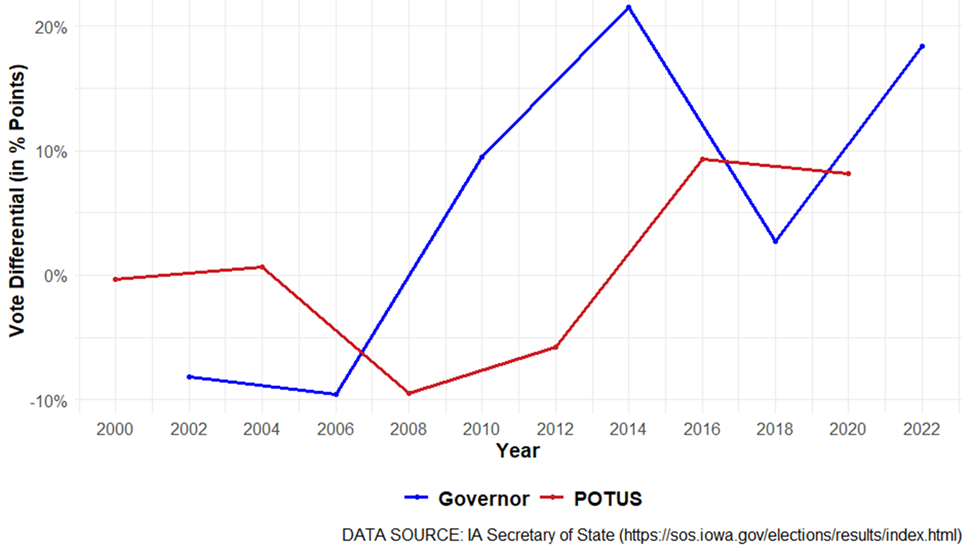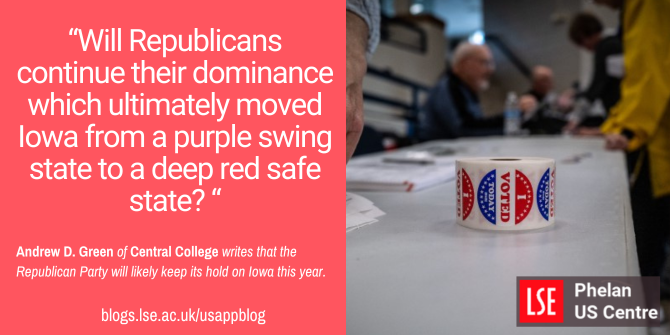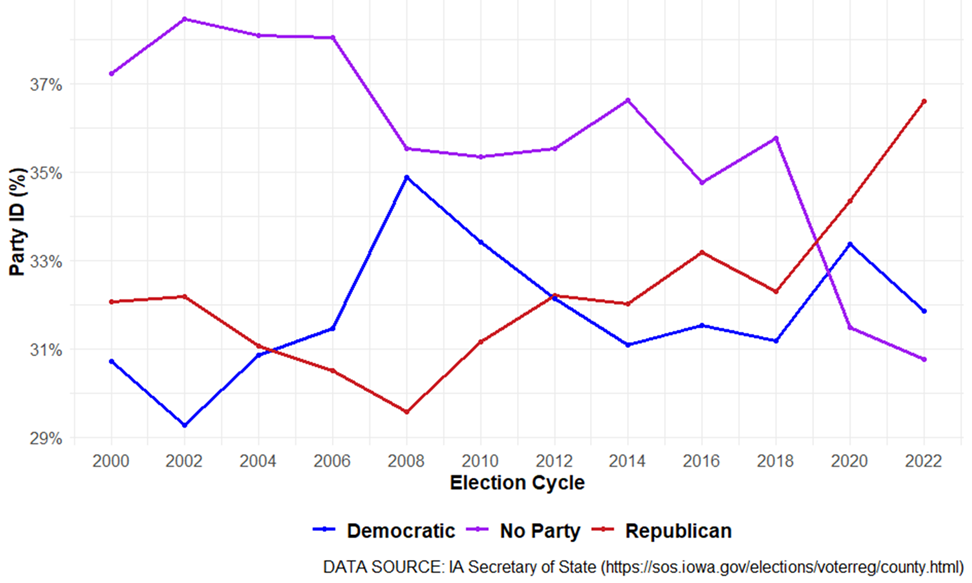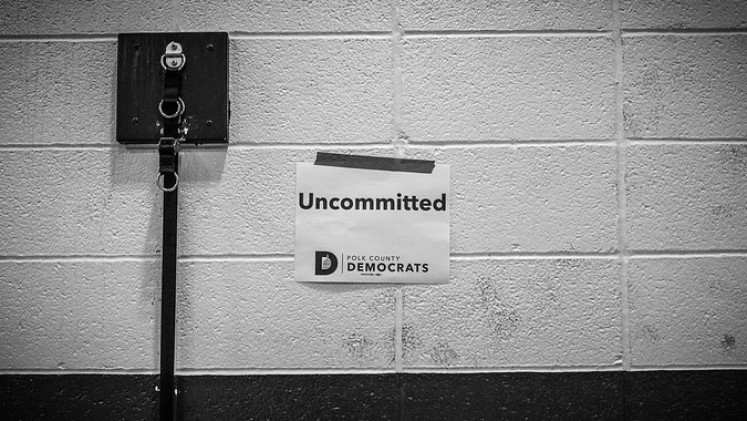 Only four years ago, Iowa was widely considered by many to be a swing state. Andrew Green looks at the Hawkeye State’s recent electoral history, writing that Republican presidential and state victories in 2020 were cemented by further victories across the state’s Congressional seats and state executive offices. Looking ahead to this year’s elections, he writes that there has been a clear shift in preference toward Republican presidential and gubernatorial candidates, a trend that is likely linked to a rising share of Republican voters, and a falling share of “No Party” voters in Iowa. In 2024, the Republican Party will likely continue its dominance of Iowa’s politics at the state and presidential levels.
Only four years ago, Iowa was widely considered by many to be a swing state. Andrew Green looks at the Hawkeye State’s recent electoral history, writing that Republican presidential and state victories in 2020 were cemented by further victories across the state’s Congressional seats and state executive offices. Looking ahead to this year’s elections, he writes that there has been a clear shift in preference toward Republican presidential and gubernatorial candidates, a trend that is likely linked to a rising share of Republican voters, and a falling share of “No Party” voters in Iowa. In 2024, the Republican Party will likely continue its dominance of Iowa’s politics at the state and presidential levels.
- This article is part of ‘The 2024 Elections’ series curated by Peter Finn (Kingston University). Ahead of the 2024 election, this series is exploring US elections at the state and national level. If you are interested in contributing to the series, contact Peter Finn (p.finn@kingston.ac.uk).
When I last wrote for this blog in May 2021, Iowa Republicans had just won a significant victory in the presidential election and won control of five of Iowa’s six Congressional seats (both Senate seats and three of its four US House seats). In thinking about the then upcoming midterms in 2022, I believed it would “be a tough task” for Iowa Democrats win back not only federal seats but also the Governor’s office and seats in the state legislature. In 2022, Republicans indeed continued their dominance in the Hawkeye state. Governor Kim Reynolds won reelection to a second term by more than 18 points. Senator Chuck Grassley won an eighth term in the US Senate and Republicans won all four US House seats. At the state level, Republicans came within 3,000 votes in the State Auditor’s race of sweeping all five executive offices in the state. The near sweep included defeating two incumbent Democrats: (1) Attorney General Tom Miller, who served as Attorney General from 1979-1991 and then consecutively since 1995; and (2) Treasurer Michael Fitzgerald, who had served as Treasurer since 1983. Iowa Republicans also expanded their majorities in both the Iowa House of Representatives and the Iowa Senate.
So, as we turn to the June primary election and the November general election, what can we expect to see in Iowa? Will Republicans continue their dominance which ultimately moved Iowa from a purple swing state to a deep red safe state? Or can Democrats begin to reverse the partisan advantages that Republicans have had since the middle of the last decade?
Iowa’s Electorate: Trends in vote choice and voter registration
Iowa’s status as a purple swing state has been written about extensively by both political scientists and political analysts. In the aftermath of the 2016 election, there were real questions about whether the Iowa electorate was realigning or whether 2016 was an outlier. With the aid of three more election cycles where Republicans have made gains statewide, it is clear that what we observed in 2016 was not a period effect but a legitimate shift in Iowa’s electorate.
To visualize the partisan changes in Iowa over time, I used general election and voter registration data from the Iowa Secretary of State’s website for every presidential and midterm election from 2000 to 2022. To examine changes in the vote choice of Iowans, I calculated the vote differential between the Republican and Democratic candidates for president and governor by subtracting the share of the vote the Democratic candidate received from the share of the vote the Republican candidate received. Thus, a positive vote differential would indicate the Republican candidate won more votes and a negative vote differential would indicate the Democratic candidate won more votes in that election. The vote differentials for each presidential (in red) and gubernatorial (in blue) election from 2000-2022 are shown in Figure 1 below.
Figure 1 – Vote differential between Republican and Democratic candidates for president and governor in Iowa, 2000-2022

The shift in preference toward Republican presidential and gubernatorial candidates is clear, particularly since 2010. Before 2014, Democratic candidates for president had won the popular vote in Iowa in three of four presidential elections with former President George W. Bush winning the popular vote by a narrow 0.7 percent in 2004. Democratic candidates for governor also faired quite well in 2002 when former Governor Tom Vilsack won reelection by over eight percent and in 2006 when former Governor Chet Culver won his first term as governor by over nine percent.

“Election Day 2022” (CC BY 2.0) by Phil Roeder
After 2010, however, is another story. In 2010, former Governor Terry Branstad returned to the political arena and flipped a 9.6 percent loss for Republicans in 2006 to a 9.5 percent victory. His vote differential more than doubled four years later when he won a sixth term as governor. In 2017 when Branstad become the US Ambassador to China, Kim Reynolds became Governor of Iowa. While her vote differential in 2018 was only 2.7 percent in her bid to win her first full term, she was overwhelmingly reelected in 2022 by 18.4 percent.
Presidential elections in Iowa
There is a similar trend in presidential elections as well. After winning Iowa in 2008 by over nine percent, former President Barack Obama’s winning margin in 2012 was nearly cut in half (5.8 percent). By 2016, former President Trump had flipped the advantages Democrats held in presidential races during the Obama years and won the popular vote by over nine percent. While his differential declined in 2020, he still handily defeated President Biden by over eight percent.
The shift toward Republican advantages in Iowa electoral politics can also be seen in voter registration data. Figure 2 below plots the party share of active registered voters from 2000-2022 with the blue line for Democrats, the red line for Republicans, and the purple line for No Party Voters. The data was taken from the voter registration report for November of each election year.
Figure 2 – Party ID of active registered voters in Iowa, 2000-2022

Three trends are visible in Figure 2. First, the share of registered Democrats stayed the same between 2000 and 2022: around 31-32 percent of the electorate. While the share of Democrats statewide did increase to a high of just under 35 percent in 2008, it steadily fell back down to around 32 percent by 2022. Second, the share of Republican voters has risen steadily since 2008. In 2008, Republicans accounted for 29.6 percent of registered voters in Iowa which was nearly five points lower than registered Democrats and six points lower than No Party Voters. By 2022, the share of Republican voters was at its highest level during the period at 36.6 percent, which was nearly five points higher than the share of registered Democrats and nearly six points higher than the share of registered No Party Voters.
Third, and probably most important for understanding why Iowa has shifted from being a purple swing state to a deep red Republican state is the significant decline in registered No Party Voters in Iowa. The share of No Party Voters in Iowa reached a peak of 38.5 percent in 2002 and remained at around 38 percent until the 2008 cycle. While there have been some small upticks in the share of No Party Voters since 2008, the overall trend is downward. In fact, by 2022 the share of No Party Voters in Iowa dropped to 30.8 percent and fell below both the share for registered Democratic voters and registered Republican voters.
What to expect in Iowa’s 2024 presidential and down ballot races
So, what can we expect to see in Iowa in 2024? Let’s start at the presidential level. Former President Trump should win Iowa handily during the general election. While much has been written about decline in Republican voter turnout in the Iowa Caucuses from 2016 to 2024, Trump won the Iowa caucuses with a majority of the vote (51 percent). The 30+ point win over his nearest Republican rivals demonstrates the level of support he has with Iowa Republicans. Additionally, recent polling data from the Des Moines Register/Mediacom Iowa Poll taken in late February 2024 shows Trump with a 15 point lead over President Joe Biden (48 percent-33 percent). 15 percent of respondents said they would vote for “someone else” in November. The Iowa Poll also reveals nearly half (49 percent) of all respondents have a favorable view of Trump while only 31 percent of respondents have a favorable view of Biden. Biden’s low favorability ratings could be a function of how Iowans view his presidency, which in a word is poor. Only 29 percent of respondents approve of how Biden is handling his job as president and 69 percent disapprove. Additionally, 79 percent of respondents believe the US is on the wrong track. Even with concerns about age and looming criminal prosecutions, Trump’s favorability advantages in Iowa coupled with the poor assessments of Biden’s presidency should give Trump significant advantages in November.
At the time of writing this post, Iowa’s filing deadline for running in the primary election for US House or the state legislature had not passed, making it difficult to assess potential shifts in the down-ballot races in November, particularly at the state legislative level. However, even though the filing deadline has not passed, and candidates could still emerge, more is known about the US House races. As of March 5, 2024, two of Iowa’s four US House races (IA-2 and IA-4) are classified as “Solid Republican” by the Cook Political Report. The northeast Iowa and northwest Iowa seats, held by incumbent Representatives Ashley Hinson and Randy Feenstra, are not viewed as in play this November.
The two seats that may be in play are IA-1 in southeast Iowa currently held by Representative Mariannette Miller-Meeks and IA-3 in southwest Iowa currently held by Representative Zach Nunn. Both are Republicans. The Cook Political Report has the IA-1 race classified as “Likely Republican” and the IA-3 race as “Lean Republican.” The Democratic challengers in these two races posted impressive fundraising numbers in their January 2024 Federal Election Commission (FEC) filings. For the second cycle in a row, Miller-Meeks is being challenged by University of Iowa law professor Christina Bohannon. Bohannon raised over $650,000 during the final quarter of 2023 and has over $1.1 million on hand for the campaign. Nunn, who is seeking reelection for the first time, faces Lanon Baccam, a veteran and former official in the US Department of Agriculture. Baccam raised over $500,000 during the final quarter of 2023 and has over $440,000 on hand for the campaign. While both challengers outraised their opponents during the filing period, both have considerably smaller amounts of campaign cash available for the campaign when compared to the campaign funds available to the incumbents they are challenging.
In the end, the Republican incumbents in these two US House races will have advantages and must be viewed as the favorites going into the fall campaign. Republicans have voter registration advantages statewide and in these two districts. As of March 1, 2024, active Republican voters outnumber active Democratic voters by nearly 150,000 statewide and by over 15,000 in both IA-1and IA-3. Additionally, they will be campaigning alongside a Republican presidential candidate who is viewed favorably in the state which could lead to some coattail effects in down ballot races. Come November 5, 2024, it would not be surprising to see Iowans assign their Electoral College votes to Trump and send all four Republican incumbents back to the US House.
- Please read our comments policy before commenting.
- Note: This article gives the views of the author, and not the position of USAPP – American Politics and Policy, nor of the London School of Economics.
- Shortened URL for this post: https://bit.ly/3Tg3eQv






